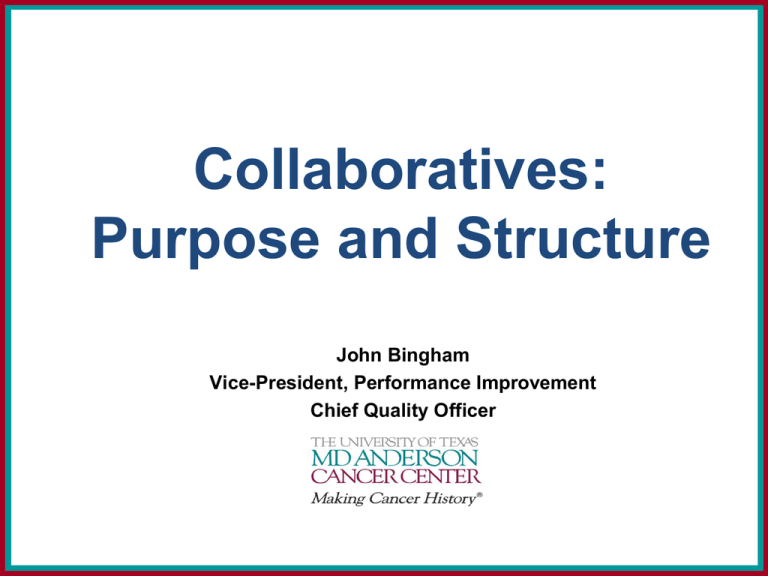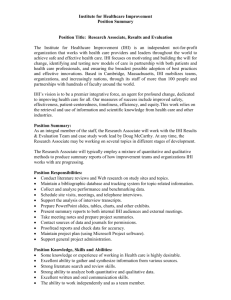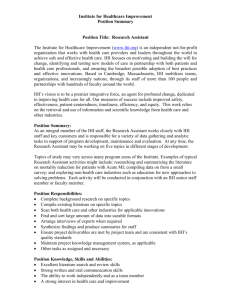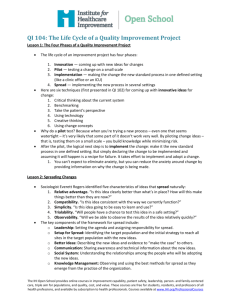Collaboratives: Purpose and Structure
advertisement

Collaboratives: Purpose and Structure John Bingham Vice-President, Performance Improvement Chief Quality Officer I keep six honest serving-men (They taught me all I knew); Their names are What and Why and When And How and Where and Who. “Just So Stories” Rudyard Kipling, 1902 What? Collaboration : A recursive process where two or more people or organizations work together in an intersection of common goals — for example, an intellectual endeavor[1] [2] that is creative in nature[3]by sharing knowledge, learning and building consensus. From Wikipedia, the free encyclopedia IHI Definition of Collaborative: “A Breakthrough Series Collaborative is a shortterm (6- to 15-month) learning system that brings together a large number of teams from hospitals or clinics to seek improvement in a focused topic area.” The Breakthrough Series Whitepaper © 2003 IHI’s Collaborative Model for Achieving Breakthrough Improvement Key Elements of IHI Collaboratives: 1. 2. 3. 4. 5. 6. 7. 8. Topic Selection Faculty Recruitment Enrollment of Organizations/Teams Learning Sessions Action Periods The Model for Improvement Measurement and Evaluation Summative Congresses and Publications How? IHI Breakthrough Series Participants Select Topic (Develop Mission) Expert Meeting (10-100 Teams) LS – Learning Session Prework Develop Framework & Changes Planning Group AP – Action Period P A P D A S D A S LS 1 LS 2 AP1 Visits © 2003 Institute for Healthcare Improvement Sponsors Publications, Congress, etc. D S LS 3 AP2 Supports: Email (listserv) Dissemination P Phone Conferences Assessments Monthly Team Reports AP3* Holding the Gains *AP3 –continue reporting data as needed to document success Who? UT Health System: 6 Number of Institutions 8,081 Number of Physicians 41,579 Number of Employees Source: The University of Texas System Fast Facts 2009 The University of Texas Health Science Center at Tyler Where? Why? 86,030 Number of UT Admissions 5,348,270 Number of UT Outpatient Visits 1,402,284 Number of UT Hospital Days ?% Percentage of UT System Patients Receiving all of the Evidence-Based Care That They Were Eligible to Receive Source: The University of Texas System Fast Facts 2009 Why? “Please… Don’t Make Me Wait… As I Have So Little Time Left!” So… What Should/Could We Do? 1. Continue with Current UT Model 2. Develop More “Robust” UT Model 3. Join One or More of IHI’s Collaboratives 4. Partner With IHI to Develop IHI/UT System Collaborative Model IHI Improvement Map Focus Areas: 70 Evidence-Based Processes New IHI Collaboratives Beginning Fall 2009: • IMPACT Leadership Community • Transforming Care at the Bedside • Improving Perinatal Care • Reducing Readmissions • Reducing Sepsis Mortality When? Now Thank You! Save the Date! David Eddy, M.D., Ph.D. on Nov. 17 Special event for CS&E Alumni • Physician-mathematician makes return to M. D. Anderson • Half-day event on use of evidencebased guidelines Plan to Attend! Nov. 17, 2009 7:30-11:30 a.m. FCT 3.4165, Room 7 (Pickens Tower)






